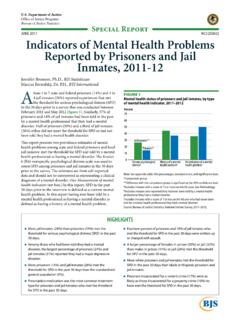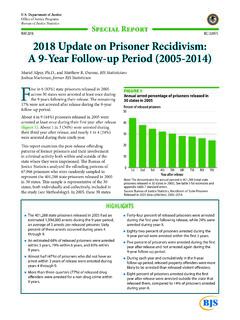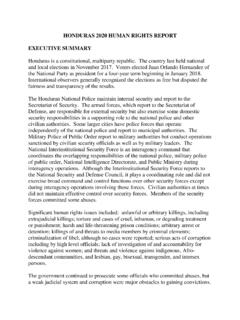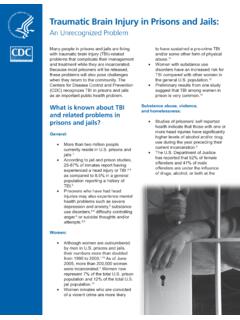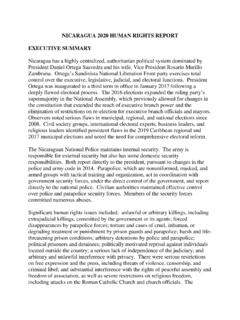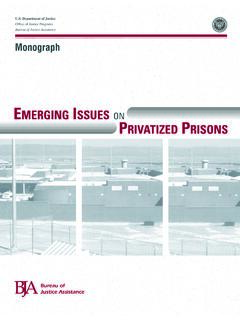Transcription of Historical Statistics on Prisoners in State and Federal ...
1 Au .. Department of Justice National Institute of Justice Department of Justice Bureau of Justice Statistics Historical Statistics on Prisoners in State and Federal Institutions, Yearend 1925-86 By Patrick A. Langan, , Jolut V. Fundis, and Lawrence A. Greenfeld BJS Statisticians, and Victoria W. Schneider, Archival Assistant Director, Inter-university Consortium for Political and Social Research, University of Michigan May 1988 NC,J-I11098 111098 , l This document has been reproduced exactly as received from the person or organization originating it. Points of view or opinions stated in this document are those of the authors and do not necessarily represent the official position or policies of the National Institute of Justice.
2 \ Permission to reprodlJce this ~material has been granted by Public nomain/BJS Department of Justice to the National Criminal Justice Reference Service (NCJRS). Further reproduction outside of the NCJRS system requires permis-sion of the c~owner. If you have issues viewing or accessing this file, please contact us at Department of Justice Bureau of Justice Statistics Steven R. Schlesinger Director Acknowledgments. This report was written by Patrick A. Langan, John V. Fundis, and Lawrence A. Greenfeld of BJS and by Victoria W. Schneider of the Inter-university Consortium for Political and Social Research at the University of Michigan. Marilyn Marbrook, BJS publications unit chief, administered production, assisted by Jeanne Harris, Christina Roberts, and Yvonne Shields.
3 Many people contributed to building the dataset used in this report. In this regard, special recognition goes to Catherine Sharpe, Robert Denk, and Dena G. Myers, staff members of the National Criminal Justice Data Archive at the University of Michigan. The Bureau of Justice Statistics wishes to acknowledge the con-tributions of those many correctional officials, both past lUld present, whose cooperation over the more than aO-year history of National prisoner Statistics made this report possible. We deeply appreciate the continuing commitment of all NPS participants to this series. The Assistant Attorney General, Office of Justice Programs, coor-dinates the activities of the following program offices aM bureaus: the Bureau of Justice Statistics , National Institute of Justice, Bureau of Justice Assist-ance, Office of Juvenile Justice and Delinquency Prevention, and the Office for Victims of G'rime.
4 Ii Prisoners in State and Federal Institutions Contents L"ltroduction 1 National trends, 1925-86 2 Regional trends, 1925-86 2 Individual State trends, 1925-86 2 Trends in the size of the Federal prison population as a percentage of the total prison population 3 Methodology 3 How to obtain the data 4 Sources 16 Tables 1. Sentenced Prisoners in State and Federal institutions on December 31, 1925-86 5 2. Average annual change in prison population, 1925-86 and 1980-86 14 3. Total number of sentenced Prisoners in State and Federal institutions and percentage of Prisoners in Federal institutions, 1925-86 15 Introduction In 1926 the Federal Government, in a statistical series called "National prisoner Statistics ," began keeping annual records of State and Federal prison populations.
5 The series has been in continuous operation ever since. Published reports from the series are the source of national statistical information on prison populations in the United states . among the several continuously pub-lished measures of the prison popu-lation, one from the annual report is intended to provide a measure of the overall size of the prison population. This measure is the number of . Prisoners present in State and Federal prisons at the end of each year. Changes from one year to the next in the number of Prisoners present at yearend reveal whether prison populations are Increasing, decreasing, or staying the same in the United states . This report combines yearend popu-lation counts from the annual pub-lished reports into a single table (table 1).
6 Table 1 shows the prison population of each State , the Dis-trict of Columbia, and the Federal Government on December 31 of each year from 1925 to 1986. Over the more than 60 years in which . prisoner counts have been reported, definitions of included populations have occasionally changed, and pub-lished figures have been revised (see Methodology). Annual counts report-ed here are based on final revised figures and represent the most com-parable data published. Historical Statistics , 1925-86 1 National trends, 1925-86 . Record bigh number of Prisoners . From 1925 to 1974 the record high prison population was in 1961, when 220,149 persons were in prison. The record was brok!JD in 1975, when the prison population reached 240,593. Every year since 1975 a new record high was set.
7 To date, the 1986 pris-on population of 563,794 is the high-est number ever recorded. It nearly equals the 1986 population of Alaska (534,600), Vermont (541,000), 01' Wyoming (507,000). Record year-to-yem' numerical increase. The largest numerical increase in the prison ever recorded was from 1981 to 1982, when the prison population grew by 41,060 Prisoners . At that rate, the equivalent of a new 1,000-bed prison would have to be built nearly every week just to keep up with prison popula tion growth. Record year-to-yem' percent&tJe increase. Over the past 62 years prison populations have typically illcreased from one year to the , next. The average year-to-year change has been a Increase (table 2). The largest year-ta-year percentage increases ever recorded have all occurred in the past 12 years.
8 The largest year-to-year increase ever recorded was from 1980 to 1981, when the prison population increased ; the second largest, , was from 1981 to 1982; the third largest, 10%, was from 1974 to 1975. From 1980 to 1986 the average year-ta-year change in the prison population was an increase of Record year-to-year percentage decrease. The largest year-ta-year percentage decrease ever recorded was from 1941 to 1942, when the prison population declined ; the second largest decline, from 1942 to 1943. was ; the third largest de-cline, from 1965 to 1966, was Regional trends, 1925-86 Record year-to-ye~ percentage increase. Over the past 62 years average year-to-year changes have been 2.'196 increases in the North-east; increases in the Midwest; increases in the ~uth; and increases in the West.
9 Year-to-year changes from 1980 to 1986 have averaged much higher: average yearly increases in the Northeast; average yearly in-creases in the Midwest; aver-age yearly increases in the South; and % average yearly increases in the West. 2 Prisoners in State and Federal Institutions Individual State trends, 1925-86 Record year-ta-year percentage mcre8BC. Over the Historical period 1925-86, the average annual change has ,been a increase. The states with the historically largest average annual ineresses (596 or more) are: Alaska Delaware Florida Nevada Arizona The states with the historically smallest average annual increases (less than 196) are: Iowa .896 Minnesota .7 West Virginia..1 The states with the largest average annual increases during the 1980's (greater than 1596) are: Alaska Hawaii Arizona Alabama California New Hampshire Nevada New Mexico The states with the smallest average annual increases during the 1980's (less than 596) are: Texas Oregon West Virginia Iowa North Carolina Tennessee 'l't'ends in the size of the Federal prison population as a percentage of the total prison population Record high percentage of Federal Pl'isoners.
10 The prison population has two components: a State prison pop-ulation (including the District of Columbia) and a Federal prison popu-lation. The Federal prison population as a percentage of the total popula-tion has fluctuated over time. From 1925 to 1945 the prevalence of Fed-eral Prisoners increased, reaching its all-time high level of in 1945 (table 3). Record low ~rcentage of Federal Prisoners . From 1945 to 1982 the prevalence of Federal Prisoners steadily declined, reaching its all-time low level of in 1982 (table 3). Since 1982 the prevalence of Federal Prisoners has been growing. Methodology National prisoner Statistics is a voluntary reporting program initi-ated by the Federal Government in 1926. The Federal agency respon-sible for administering the program was the Bureau of the Census from 1926 to 1949, the Federal Bureau of Prisons from 1950 to 1970, the Law Enforcement Assistance Administra-tion from 1971 to 1978, and the Bureau of Justice Statistics from 1979 to the present.










